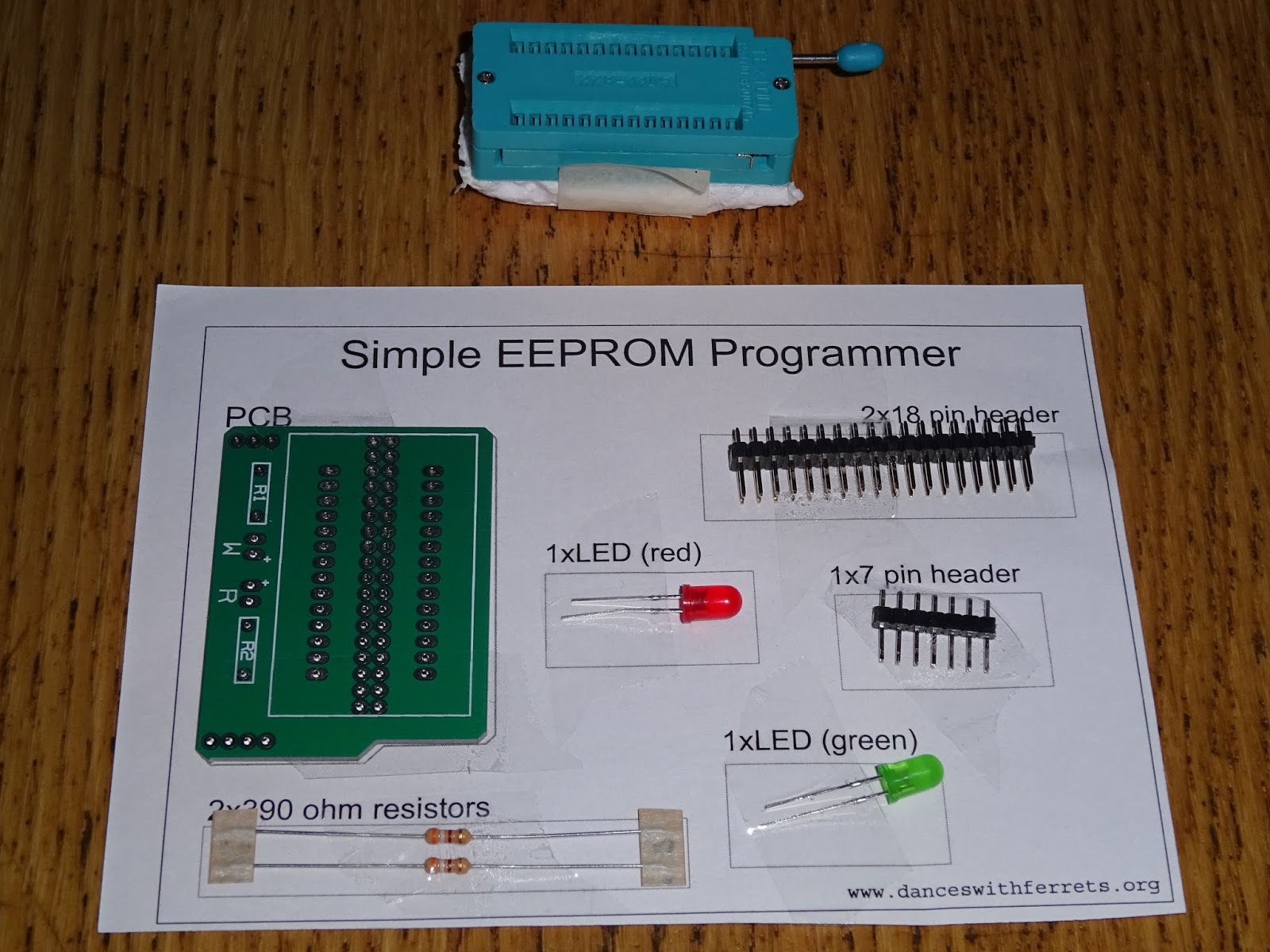2003-04-18
The Idea here is to store a set of simple type variables sequentially in the EEPROM at a specific EEPROM address. Just attach a push button connected to ground and pin 5 of the Arduino. On start up the EEPROM values are retrieved from the EEPROM and sent to serial Monitor. When you push the button random values are saved to the EEPROM. Simple EEPROM Programmer This is a simple project for reading 28-pin ROMs, and for reading or writing 28-pin EEPROMs. It works with the pinout of ROMs and EEPROMs like 28c64, 28c128, 28c256, and so on.
Here is a simple serial (I2C) EEPROM programmer for the PC parallel port. I built it to program 24XX devices, but it can, in principle at least, talk to any I2C device with a suitable adapter or fly-lead, it implements a complete I2C bus interface. SIMPLE EPROM PROGRAMMER A simple EPROM programmer is described here. It connects to a PC's parallel port and can program EPROMs from 2716 to 27512. The design can be expanded to program even larger EPROMs. DOS based software is available to program EPROMS from various data file formats. EPROM Programmer Design This programmer is shown in.
Here is a simple serial (I2C) EEPROM programmer for the PC parallel port. I built it to program 24XX devices, but it can, in principle at least, talk to any I2C device with a suitable adapter or fly-lead, it implements a complete I2C bus interface.
The original prototype and control software was developed against a 24LC16B device, but has since been extended and tested against the 24LCX range with X in { 08, 16, 21, 32, 64, 128, 256 }. It should work fine with other 24X I2C EEPROM devices, perhaps with slight changes to the addressing logic and sizing for larger devices like the 24LC512 (and 24LC1024 when it becomes available). Adding an extra device is generally just a matter of adding an extra struct near the top of 24xx.c and recompiling.
Serial Eeprom Programmer
One exception might be the power supply. The 24LC16B and other similar chips pull just a little more than 3 mA when writing to power the internal programming voltage generator (less when reading, and virtually nothing in standby). The programmer is port powered but the parallel port outputs are specified to source only 3.5 mA. That is cutting it a bit fine, but in practice it has worked perfectly on several different PC parallel ports.
Power is sourced from the C0 bit, on some weird parallel ports this may be open collector rather than being capable of sourcing current. If yours is one of them, or you suffer other power problems, you can try pulling power from D2-D7 and C2-C3 with extra diodes, they are all pulled up by the software. If all else fails, supply an external 5 V supply. The diodes will protect the port if external power is supplied, especially if you intend to use the programmer as a generic I2C interface.
Note the switch/jumper in the diagram that allows selection of the state of the /WP signal on most devices. This was added after support for the 24LC21A was requested by Miika Ahdesmäki. The 24LC21A's /VCLK signal has the opposite sense to the usual /WP, as do several others designed for plug-n-play data service. The driver was also modified to pre-clock it as per the requirements in its datasheet to get it into the bi-directional operation mode.
A bi-directional parallel port is not required as the SDA and SCL lines are read through the Error and Paper-Out status bits (S3 and S4). The C1 bit drives a power indicating red LED (or a 'don't remove chip' warning if you prefer). The D0 and D1 lines drive the pull-down of SDA and SCL, they have a yellow and green LED to display their states. (The state of the pull-down drive, not SDA and SCL themselves! You may wish to add two more transistors to drive the LEDs from the bus state instead, making them more useful.)
You can download my Linux user space programmer drivers. They call ioperm() to establish access to the I/O space for the parallel port so they must be run as root, or setuid root. Currently the I/O base is hardcoded for the 1st parallel port at 0x378. The code is interactive, entering '?' at the prompt will give you a list of options:
Commands: q Quit ? This usage message d Dump EEPROM, as hex D <start> <len> Dump EEPROM, as hex f <value> Erase EEPROM, filling with value r <filename> Dump EEPROM into raw binary file w <filename> Program EEPROM from raw binary file t <type> Set EEPROM device type (as 24C<type>) p <delay> Set delay between I2C transitions (for slower devices)It is fairly primitive right now, it only supports raw binary input and output files, but I intend to add support all the common hex-file formats. It already has the option to dump the data pretty-printed in hex for manual inspection, and can fill the device with a specified byte to clear it or test it for bit failures near its end of life.
It would not be very challenging to make this code portable to Win32 console, just replace the inb/outb() and ioperm() calls. All else should port directly. This is true for all remotely POSIX systems, as long as they have some facility to allow user space programs to invoke I/O instructions.
Simple Eeprom Programmer Tutorial
10 comments.

